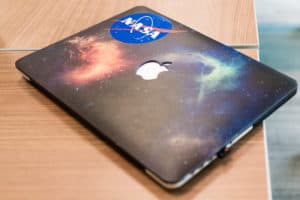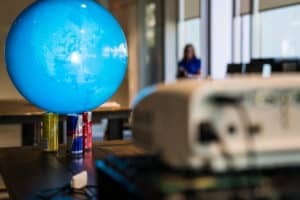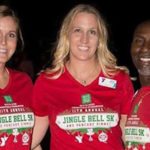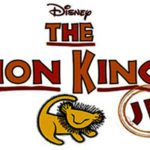Q: What do these things have in common?
- A Twitter bot that crowdsources STEM articles to aid in research.
- A tool that plans energy consumption based on solar output.
- A scale model of the Earth that predicts natural disasters.
- An app that allows users to calculate the ROI of a residential or commercial solar array.
- A lunar habitat that monitors the health and comfort of those living inside.
A: They were all invented in Lake Nona recently as part of a NASA competition!
The NASA Space Apps Challenge is a global, two-day hackathon focused on solving real-world problems. In the six years since the hackathon launched, it has grown from 25 to 187 locations. There were 25,000 participants in 2017. This year, NASA called for “coders, scientists, storytellers, makers, builders, technologists, and everyone enthusiastic about space” to compete. The Guidewell Innovation Center was host to five competing teams.
A “hackathon” is a sprint to solve a problem or complete a challenge. This challenge focuses on solving problems using real data that NASA provides. Categories included data interpretation, ecological systems, natural disasters, aquatic systems, and sociological and economic interactions.
 The teams toiled for 48 hours to solve their challenge. Finally, they presented to a panel of five judges, pitching their solution. Solutions are judged on the following criteria: impact, creativity, product, sustainability, and presentation. Keynote speaker Jim Thomas and judges Cassandra Wilcox, Chris Edwards, Joshua “TechDev” Walker, Alyssa Nicoll, and Matt Lavoie rounded out an all-star Orlando-area tech presence.
The teams toiled for 48 hours to solve their challenge. Finally, they presented to a panel of five judges, pitching their solution. Solutions are judged on the following criteria: impact, creativity, product, sustainability, and presentation. Keynote speaker Jim Thomas and judges Cassandra Wilcox, Chris Edwards, Joshua “TechDev” Walker, Alyssa Nicoll, and Matt Lavoie rounded out an all-star Orlando-area tech presence.
The problems presented are complex. NASA researchers provide real-world problems, and teams use actual data provided by NASA to solve them. The com petition pushes participants to venture outside of their comfort zone for solutions. One of the participants was overheard saying, “I’m going home to learn some C# (a programming language) for tomorrow.”
Holly Akers organized the Orlando Space Apps Challenge event this year. She became involved with the Space Apps Challenge in 2016 through a chance meeting. The connection was made at a gathering called Nerd Nite at a comic shop called Geek Easy (why can’t we have something like that in Lake Nona)?
After assisting with the event in 2016, Holly stepped up to coordinate the 2017 event. Her reason for volunteering to organize the weekend-long event was simple. “NASA provokes curiosity, wonder and accomplishment – it’s something good to be a part of. … Everyone seems to work together in Orlando. It’s for the common good.”
Last year, the Orlando event took place downtown. Holly felt a positive impact from holding the challenge in Lake Nona’s Guidewell Innovation Center: “You have to set up the right environment. … You want to set the participants up for success.
The Guidewell Innovation Center is a place where you can be very creative. … It gives the right atmosphere for what we needed. The challenges are tough. It’s only fair to create the right environment to solve them.”
Teams competed for prizes donated from Orlando area tech businesses. Mentorship packages, memberships to Orlando Tech, and Canvs tech startup co-working space were all on the line. After the presentations concluded and the judges deliberated, two teams rose to the top of the competition. Team SpaceBot’s STEM Twitter bot earned top honors. Team FIT’s 3D global visualization earned second place as well as the people’s choice award. These two teams will go on to compete in the final global competition.
NASA also extended a special invitation to all participants: a tour of their Swamp Works. The Swamp Works is a NASA think tank where their mantra is, “Make it, test it, and improve it.” A fitting experience for hackathon contestants!
After all, as Holly Akers said, “The idea is collaboration over competition. When you bring people together and collaborate over complex problems, something good will come of it.”
For more information on the 2017 Space Apps Challenge, visit http://nonahood.to/nasa2017.





